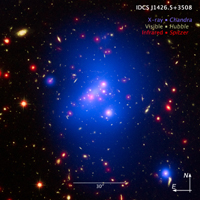
Annotated Version
Download the high resolution TIFF file
Click on the image for larger browse versionAstronomers have made the most detailed study yet of an extremely massive young galaxy cluster using three of NASA's Great Observatories. This multi-wavelength image shows this galaxy cluster, called IDCS J1426.5+3508 (IDCS 1426 for short), in X-rays recorded by the Chandra X-ray Observatory in blue, visible light observed by the Hubble Space Telescope in green, and infrared light detected by the Spitzer Space Telescope in red.
This rare galaxy cluster, which is located 10 billion light-years from Earth, is almost as massive as 500 trillion suns. This object has important implications for understanding how such megastructures formed and evolved early in the universe. The light astronomers observed from IDCS 1426 began its journey to Earth when the universe was less than a third of its current age. It is the most massive galaxy cluster detected at such an early time.
First discovered by the Spitzer Space Telescope in 2012, IDCS 1426 was then observed using the Hubble Space Telescope and the Keck Observatory to determine its distance. Observations from the Combined Array for Millimeter-wave Astronomy indicated it was extremely massive. New data from the Chandra X-ray Observatory confirm the galaxy cluster's mass and show that about 90 percent of this mass is in the form of dark matter -- the mysterious substance that has so far been detected only through its gravitational pull on normal matter composed of atoms.
There is a region of bright X-ray emission (seen as blue-white) near the middle of the cluster, but not exactly at the center. The location of this "core" of gas suggests that the cluster may have had a collision or interaction with another massive system of galaxies relatively recently, perhaps within about the last 500 million years. This would cause the core to slosh around like wine in a moving glass and become offset, as it appears to be in the Chandra data. Such a merger would not be surprising, given that astronomers are observing IDCS 1426 when the universe was only 3.8 billion years old. Scientists think that, in order for such an enormous structure to form so rapidly, mergers with smaller clusters would likely play a role in the large cluster's growth.
In addition, while still extremely hot, the bright core contains cooler gas than its surroundings. This is the most distant galaxy cluster where such a "cool core" of gas has been observed. Astronomers think these cool cores are important in understanding how quickly hot gas cools off in clusters, influencing the rate at which stars are born. This cooling rate could be slowed down by outbursts from a supermassive black hole in the center of the cluster. Apart from the cool core, the hot gas in the cluster is remarkably symmetrical and smooth. This is another piece of evidence that IDCS 1426 formed very rapidly in the early universe.
Astronomers note that, despite the high mass and rapid evolution of this cluster, its existence does not pose a threat to the standard model of cosmology.
The Hubble Space Telescope is a project of international cooperation between NASA and ESA (European Space Agency). NASA's Goddard Space Flight Center manages the telescope. The Space Telescope Science Institute (STScI) in Baltimore, conducts Hubble science operations. STScI is operated for NASA by the Association of Universities for Research in Astronomy in Washington, D.C.
NASA's Jet Propulsion Laboratory, Pasadena, California, manages the Spitzer Space Telescope mission for NASA's Science Mission Directorate in Washington. Science operations are conducted at the Spitzer Science Center at the California Institute of Technology in Pasadena. Spacecraft operations are based at Lockheed Martin Space Systems Company, Littleton, Colorado. Data are archived at the Infrared Science Archive housed at the Infrared Processing and Analysis Center at Caltech. Caltech manages JPL for NASA.
More information about the NASA Great Observatories mentioned in this image caption is available at http://www.spitzer.caltech.edu, http://chandra.si.edu, http://hubblesite.org.

